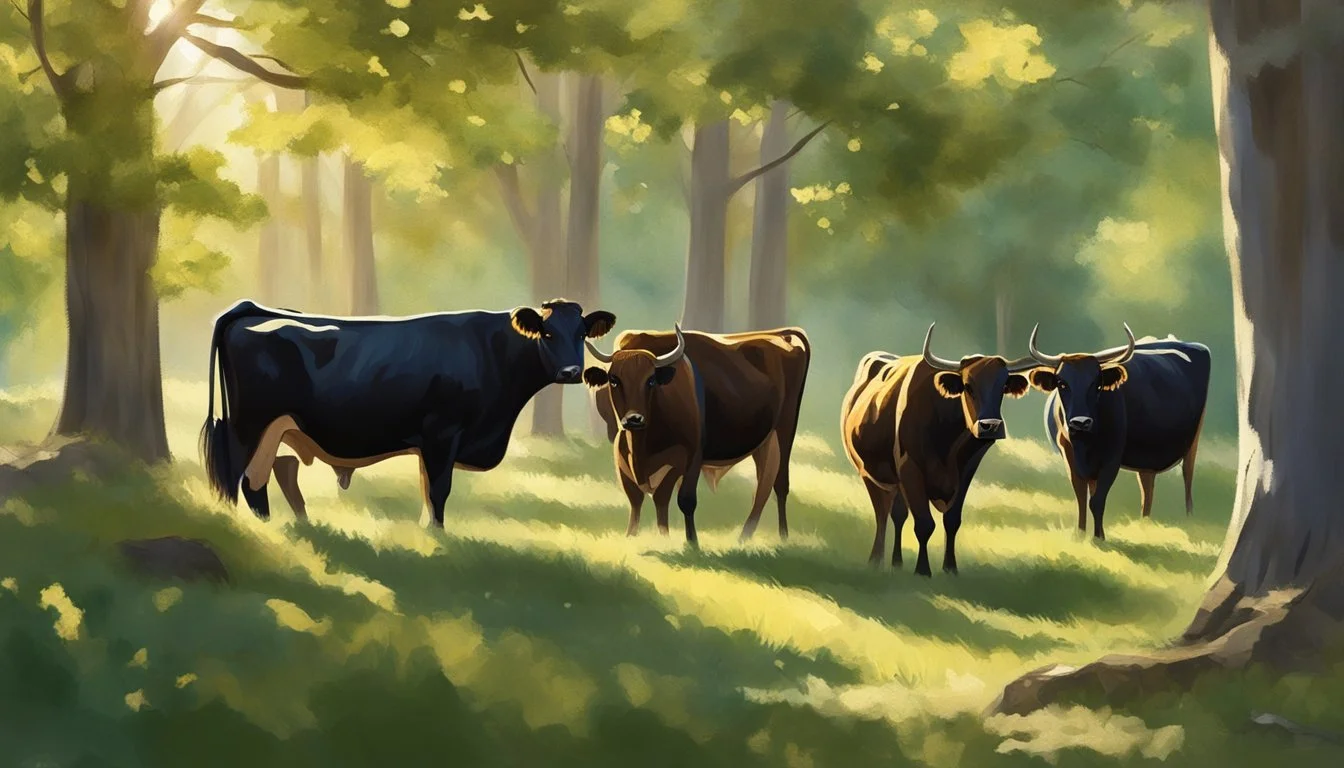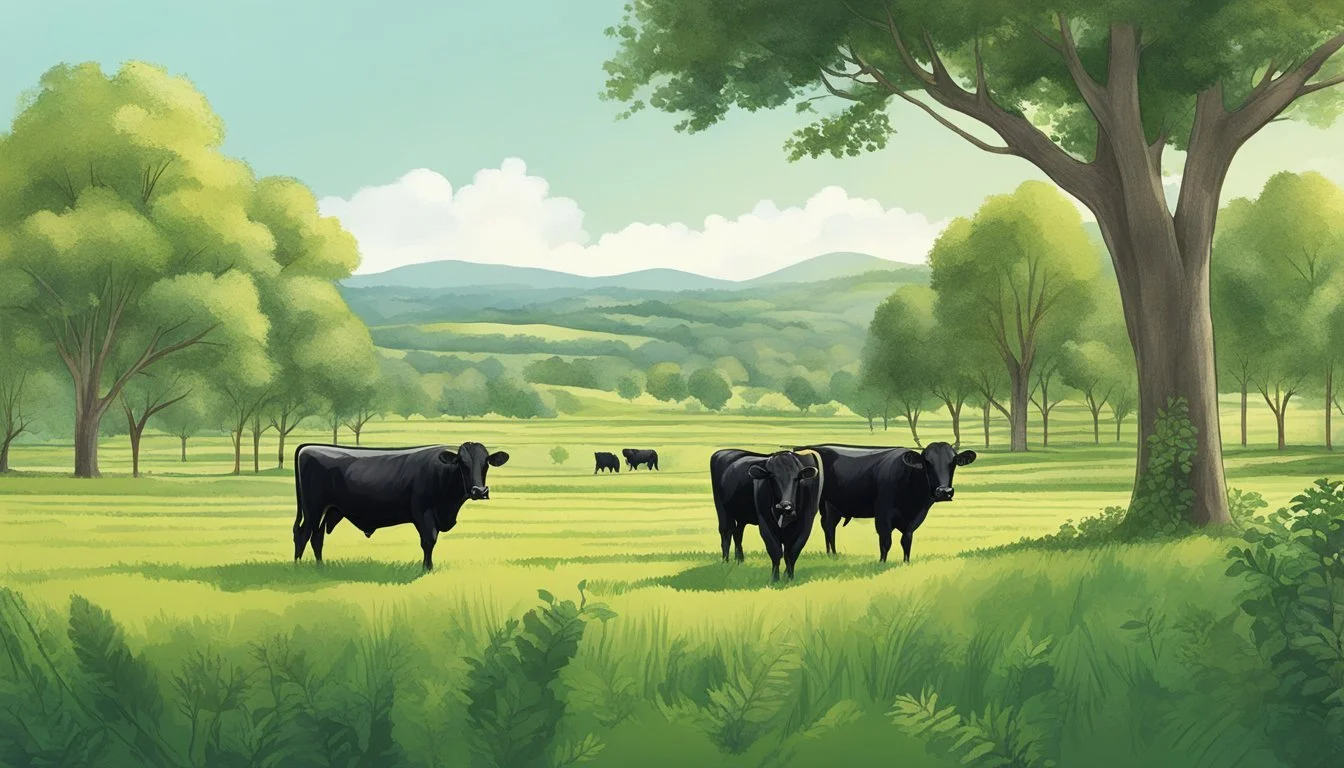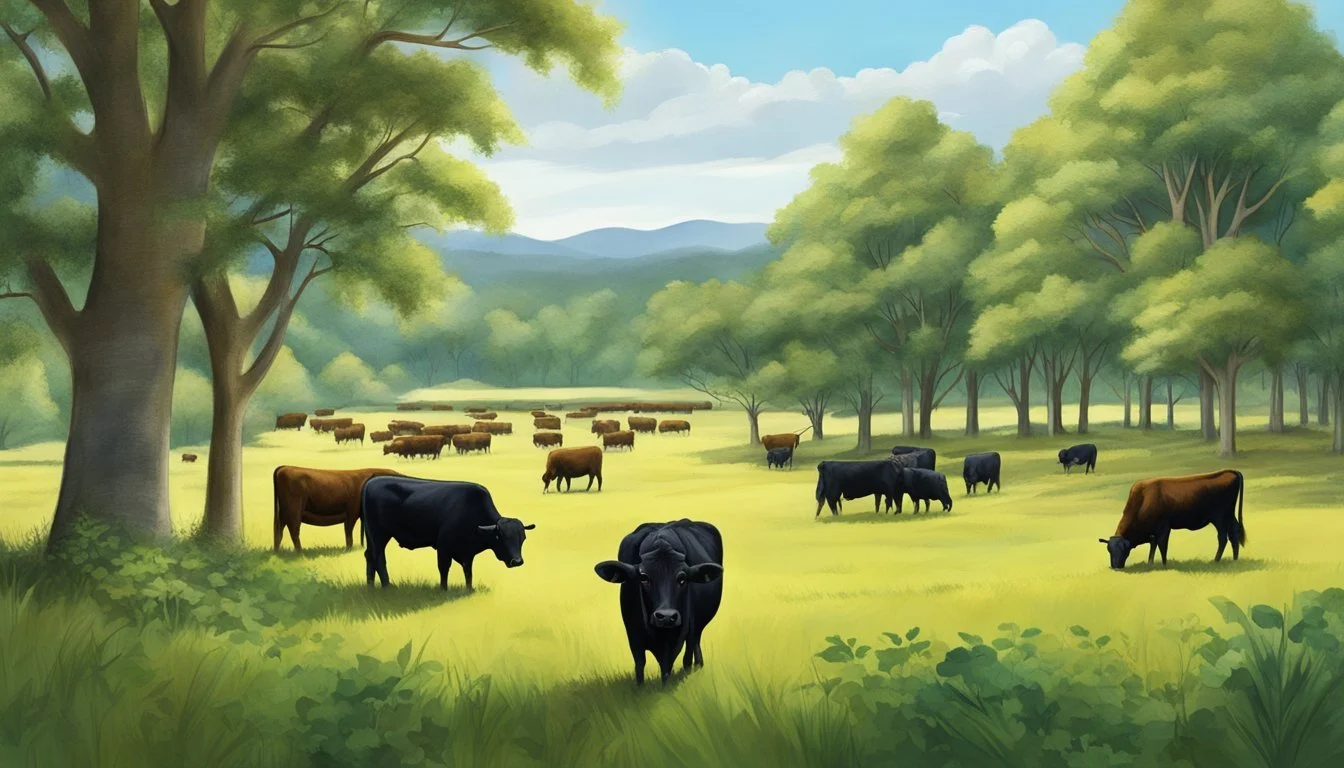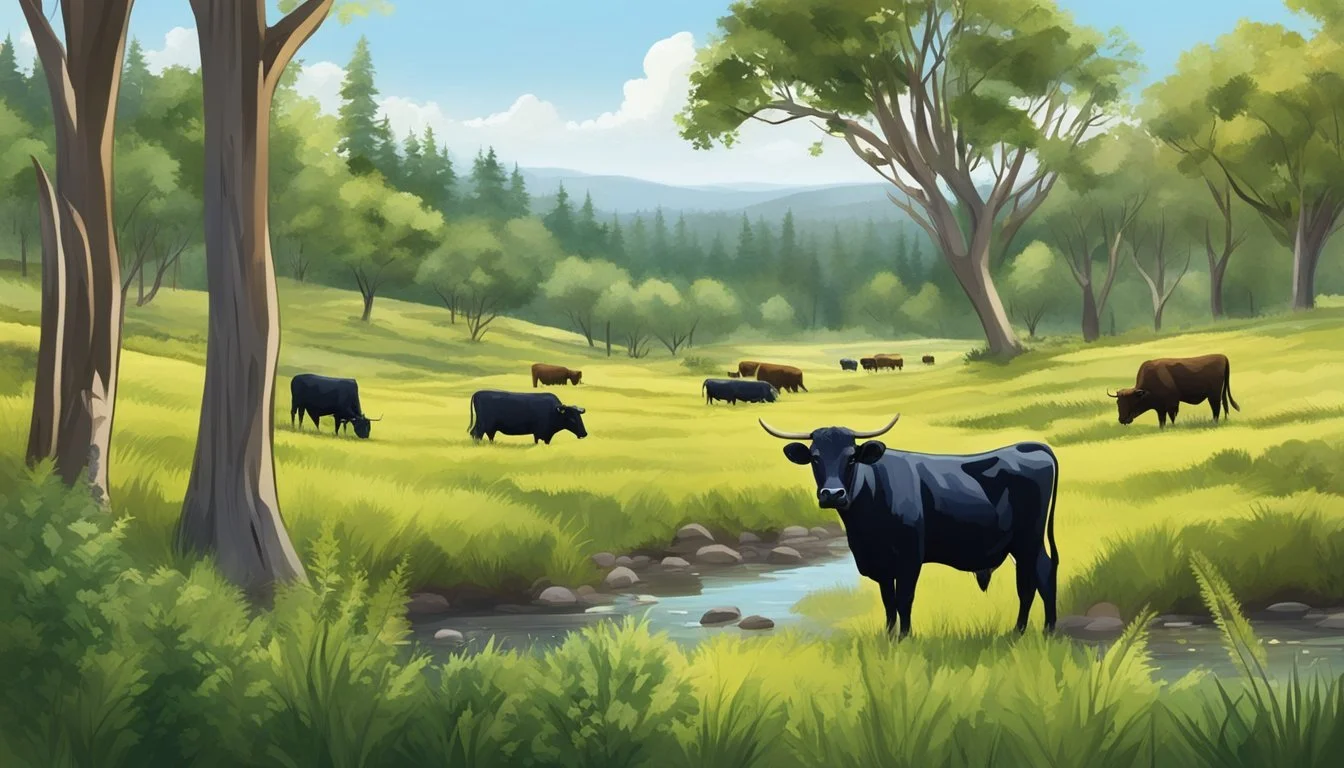Dexter Cattle and Forest Farming
Revolutionizing Sustainable Agriculture
Agroforestry, the practice of integrating trees with crops and/or livestock, is a land management system that leverages the interactive benefits between different biological communities to enhance biodiversity, improve farm yields, and contribute positively to the environment. This approach to farming and land use is not just diverse in its application but also adaptable to various climatic conditions and agricultural landscapes. In the United States, agroforestry is officially recognized and categorized into specific practices, such as forest farming, which enables farmers to cultivate shade-loving crops under the canopy of existing forests.
One innovative example of agroforestry in action is the incorporation of Dexter cattle into forest farming systems. The Dexter breed, known for its hardiness and smaller size, is particularly well-suited for pasture-based systems, including those that incorporate wooded areas or silvopasture—a system that combines forestry and grazing of domesticated animals in a mutually beneficial way. This integration can lead to the creation of a sustainable and productive agricultural environment where trees and livestock coexist, providing multiple streams of income for farmers while also promoting ecological health.
The synergy between Dexter cattle and forest farming exemplifies agroforestry at its best. By allowing livestock to graze in a forested landscape, farmers can achieve a sustainable cycle of food production and land management that supports biodiversity and soil health. This system also contributes to the well-being of the cattle, offering them a varied and natural diet that can influence the quality of the produce. Embracing such practices encourages a balance between agricultural development and environmental stewardship, positioning agroforestry as a forward-thinking solution to modern farming challenges.
The Basics of Dexter Cattle
Dexter cattle, small in stature but robust in productivity, are a fitting breed for sustainable farming practices such as agroforestry.
History and Origin
Dexter cattle have their roots in Ireland, with their existence dating back to the early 19th century. They are believed to be a descendant of the native Irish mountain cattle, related to the Kerry breed, albeit smaller. Historically, Dexters were the working cattle of smallholders, valued for their dual-purpose capabilities.
Characteristics of Dexter Cattle
Size: Adult Dexters stand about 36-44 inches at the shoulder.
Weight: They typically weigh 600 to 700 pounds.
Coat: The coat comes in three colors—black, red, and dun.
Temperament: Known for being docile and easy to handle.
Milk Production: A Dexter cow can produce approximately 1½-2½ gallons of milk per day, with a high butterfat content of 4%-5%, excellent for cheese and butter production.
Horns: Dexters can be horned or polled (without horns), with the horned variety having short, thick horns.
Advantages of Dexter Cattle in Agroforestry
Dexters are particularly well-suited for agroforestry due to their efficient grazing habits and small size, which reduces the damage to trees and understory. They are hardy animals, adaptable to a variety of climates and terrains, making them an excellent choice for integrating into forest farming systems. Their docility also makes them ideal for close management in a diversified agricultural ecosystem.
Forest Farming Fundamentals
Forest farming is an agroforestry practice that intentionally integrates the cultivation of crops within a forested ecosystem, utilizing the forest canopy to create a productive and sustainable agricultural system.
Core Concepts in Forest Farming
In forest farming, the forest ecosystem's natural layers, including trees, shrubs, and the forest floor, are mobilized to nurture a diverse range of crops. The primary goal is to cultivate high-value products under the partial shade of the forest canopy. In the United States, it's recognized as one of the five main agroforestry practices.
Key elements in forest farming consist of:
Site Selection: Careful assessment of soil fertility, water availability, and shade tolerances.
Plant Cultivation: Inclusion of medicinal plants, ornamentals, and other non-timber forest products (NTFPs) suited to the understory environment.
Canopy Management: Strategic thinning of the canopy to control light levels, which is critical for the growth of the understory crops.
Integrating Livestock into Forest Farms
Incorporating livestock into a forest farm can provide multiple benefits if managed appropriately. Livestock can help with controlling herbaceous vegetation, recycling nutrients, and diversifying farm income. Here are specific practices and considerations for successfully integrating livestock:
Animal Choice: Dexter cattle and similar breeds are suitable for forested environments due to their smaller size and lighter foraging impact.
Impact on Forest Growth: Livestock should be managed to prevent overgrazing, which can negatively affect tree regeneration and the overall health of the forest understory.
Fencing and Rotation: Proper fencing is essential to limit access and protect both livestock and delicate forest crops. Rotational grazing in designated areas minimizes soil compaction and allows for forest floor recovery.
By adhering to these fundamental strategies, forest farming practitioners can create synergistic systems that leverage the strength of both flora and fauna.
Agroforestry Systems and Practices
Agroforestry strategically combines agricultural and forestry techniques to enhance productivity, economic viability, and environmental stewardship. This section delves into silvopasture as a prominent agroforestry practice and explores its benefits and other agroforestry methods.
Silvopasture Explained
Silvopasture is a sustainable agriculture approach where trees and pastures are integrated with livestock management. In this system, trees are often deliberately planted in a way that optimizes the availability of pasture for grazing while providing beneficial shade and shelter. This combination enhances land use and can lead to improved livestock welfare and growth.
Advantages of Silvopasture
Silvopasture systems offer numerous advantages:
Efficiency: They make efficient use of land resources by producing multiple outputs—timber, livestock, and sometimes additional crops.
Soil Health: The presence of trees improves soil quality by contributing organic matter and cycling nutrients.
Biodiversity: By providing varied habitats, silvopasture can support a wider range of species compared to monoculture farming.
Climate Resilience: Trees can help moderate the microclimate, potentially reducing stress on animals during extreme weather and mitigating the impact of drought by improving water retention.
Other Agroforestry Practices
Apart from silvopasture, agroforestry encompasses several other practices:
Alley Cropping: In this practice, crops are grown in the spaces between rows of trees or shrubs, which can provide wind protection, improve water usage, and prevent soil erosion.
Forest Farming: Also known as multi-story cropping, it involves cultivating shade-tolerant crops beneath the canopy of established forests.
Riparian Buffers: These are vegetated areas near water courses designed to intercept pollutants and provide wildlife habitat.
Windbreaks: Strategic planting of trees or shrubs to reduce wind speed across agricultural fields, protecting crops and reducing erosion.
Ecosystem Benefits of Agroforestry
Agroforestry practices intertwine agricultural productivity with environmental stewardship, effectively enhancing biodiversity, soil health, and climate resilience while also actively participating in carbon sequestration and weather mitigation.
Biodiversity and Conservation
Agroforestry provides a structured habitat that supports a diverse array of plant and animal species. By integrating trees into farm landscapes, they foster ecological niches for wildlife, improving species richness and ecosystem complexity. This practice not only conserves existing flora and fauna but also contributes to the restoration of degraded lands, offering corridors and sanctuaries for native species to thrive.
Soil Health and Carbon Sequestration
The introduction of trees into agricultural land plays a crucial role in soil quality enhancement. Deep-rooted trees stabilize the soil, reduce erosion, and promote nutrient recycling through leaf litter decomposing into fertile humus. Furthermore, agroforestry systems act as significant carbon sinks. Trees absorb atmospheric carbon dioxide, storing carbon in both biomass and soil, mitigating greenhouse gas emissions and contributing to global carbon cycle balance.
Climate Resilience and Weather Mitigation
Agroforestry systems exhibit a noteworthy aptitude for withstanding extreme weather events and adapting to changing climatic conditions. The presence of trees can moderate temperatures, buffer against wind and storms, and influence local rainfall patterns. These systems minimize risks associated with climate variability and ensure a level of production stability in the face of climate change, essential for maintaining food security and farmer livelihoods.
Agroforestry for Farm Productivity
Integrating agroforestry in farm management enhances productivity, specifically through increasing forage quality and availability, diversifying income streams, and improving livestock health and welfare. These advancements contribute substantially to the operational success and sustainability of farms.
Increasing Forage Availability
Agroforestry systems, particularly when involving Dexter cattle and forest farming, show a marked improvement in forage availability. By planting fodder trees and shrubs that thrive in the understory of forests, farmers can extend the grazing season and enrich the diet of their livestock. These fodder species often have deep rooting systems which make nutrients available from deeper soil layers, indirectly benefiting the pasture growth on the surface.
Benefits for Dexter cattle grazing:
Extended grazing season due to diverse forage species.
Increased forage yield with strategic tree coverage reducing grass evaporation.
Diversification of Farm Income
Economic benefits of agroforestry also include the diversification of farm income. Beyond the primary income from livestock, farms can harvest timber, fruit, nuts, and other non-timber forest products. This not only mitigates risk by providing multiple revenue streams but also enhances the overall productivity and resilience of the farm to market fluctuations.
Income streams from agroforestry:
Sale of timber and non-timber forest products.
Possible premiums for eco-friendly or sustainably-raised cattle products.
Enhancing Livestock Health and Welfare
Agroforestry practices can have a profoundly positive impact on the health and welfare of livestock. Trees provide shelter from extreme weather, reduce stress, and can lead to an overall improvement in livestock growth rates and milk production. The diverse flora promotes a balanced diet which is critical for the immune system of the cattle.
Health benefits for livestock:
Shelter and shade enhance cattle comfort and reduce heat stress.
Varied diet from different forage plants boosts immunity and productivity.
Challenges and Strategies in Agroforestry
In the realm of agroforestry, practitioners encounter several challenges that demand strategic planning and adaptive management. These obstacles often stem from environmental pressures and the inherent risks associated with long-term investment in land-use practices.
Dealing with Invasive Plants
In agroforestry systems, the presence of invasive plants can disrupt the delicate balance between crops and trees. These invasive species compete with native flora for resources, hindering growth and yield. To combat this:
Maintain vigilant monitoring to detect invasions early.
Employ mechanical removal techniques or targeted grazing by livestock like Dexter cattle, which can effectively manage underbrush without damaging trees.
Drought Management and Survival Strategies
Drought conditions present a significant challenge for agroforestry, threatening the survival of both trees and crops. Effective strategies include:
Implementing irrigation systems designed for water efficiency, such as drip irrigation.
Selecting drought-resistant species that can tolerate low-water conditions, thus ensuring the system's resilience.
Risk and Investment in Agroforestry
The initial investment in agroforestry is often high with returns that are realized over a longer period. Managing risk involves:
Diversifying agroforestry practices to spread economic risk.
Pursuing appropriate financing options tailored for longer-term investments.
Building a buffer into financial planning to account for potential short-term losses.
In adopting these strategies, stakeholders can navigate the complexities of agroforestry and harness its potential for sustainable production and ecological benefits.
Potential Agroforestry Products
In agroforestry systems, a variety of products can be obtained, ranging from edible delicacies to valuable medicinal plants. The integration of trees and shrubs into agricultural land-use systems diversifies outputs, creating a tapestry of both edible and non-edible products.
Edible Products from Agroforestry
Fruits: Tree crops such as apples, pears, and cherries can be integrated into agroforestry systems. These fruit trees can provide shade to understory crops, improve soil health, and yield delicious fruits that are marketable for fresh consumption or value-added products.
Type of Fruit: Apples
Harvest Season: Fall
Use: Fresh eating, cider
Type of Fruit: Pears
Harvest Season: Late Summer
Use: Fresh eating, preserves
Type of Fruit: Cherries
Harvest Season: Early Summer
Use: Fresh eating, baking
Nuts: Nut trees like walnuts and hazelnuts serve multiple functions; they can act as windbreaks and produce high-protein nuts. Nuts are used in food products, oils, and can be sold raw or processed.
Type of Nut: Walnuts
Yield Per Tree: 50-80 lbs
Use: Baking, snacks, oil
Type of Nut: Hazelnuts
Yield Per Tree: 25-30 lbs
Use: Spreads, snacks
Honey: Beekeeping in agroforestry systems allows for the production of honey. Bees thrive around diverse plant species and contribute to pollination, increasing crop yields while producing this sweet byproduct.
Non-Edible and Medicinal Products
Medicinal Herbs: Certain shrubs and trees are cultivated for their medicinal properties. Examples include willow bark, known for its pain-relieving salicin, and ginseng, which is valued in herbal medicine for its restorative qualities.
Herb: Willow Bark
Medicinal Use: Pain relief
Part Used: Bark
Herb: Ginseng
Medicinal Use: Cognitive enhancement
Part Used: Root
Mushrooms: Log and forest floor cultivation in agroforestry systems enable the production of gourmet and medicinal mushrooms. Varieties like shiitake and reishi are cultivated for both their flavor and health benefits.
Mushroom Type: Shiitake
Use: Culinary
Cultivation Method: Logs, Wood chips
Mushroom Type: Reishi
Use: Medicinal
Cultivation Method: Logs, Wood chips
These products underscore the versatility and richness of agroforestry as a farming practice. The synergy between trees, crops, and animals in these systems creates a holistic approach to land management, enhancing biodiversity and sustainability.
Agroforestry and Wildlife
Agroforestry practices support wildlife by creating diverse habitats and providing essential resources. By merging the cultivation of trees with agriculture, agroforestry enhances biodiversity and offers vital spaces for wildlife to thrive.
Habitat Creation and Protection
Agroforestry contributes to the creation and protection of wildlife habitats. Trees and shrubs, when integrated with agricultural land, provide shelter, nesting sites, and food sources for a variety of animals. This mixed land use approach not only bolsters the agricultural productivity but also contributes to habitat diversity. The presence of multiple layers of vegetation mimics natural ecosystems, which is conducive to sustaining a wide array of wildlife species.
Benefits for Wildlife Habitat:
Structural Diversity: Various heights and types of vegetation offer disparate niches for wildlife.
Corridors: Tree rows can act as travel corridors for wildlife, connecting disparate habitats and reducing the risks associated with moving across open areas.
Seasonal Resources: Agroforestry systems can provide year-round resources such as food and shelter, helping to support wildlife across different seasons.
Integrating Chickens and Beekeeping in Agroforestry
Incorporating chickens and beekeeping within agroforestry systems can be mutually beneficial. Chickens forage on the forest floor, controlling pests and fertilizing the soil, which enhances the health and productivity of the agroforestry system. Beekeeping, on the other hand, introduces pollinators that increase crop yields and promote biodiversity.
Chickens in Agroforestry:
Pest Control: Their foraging behavior can reduce pest populations naturally.
Soil Improvement: Chicken manure serves as a valuable source of nutrients for plants.
Beekeeping in Agroforestry:
Pollination: Bees enhance pollination for a wide range of plants, bolstering biodiversity.
Honey Production: Bees produce honey, which can be an additional source of income for agroforesters.
Case Studies and Global Perspectives
The expansion of agroforestry systems is gaining momentum globally as a sustainable agricultural practice. This section explores specific case studies from Europe and Wisconsin, demonstrating the multifaceted benefits of agroforestry in terms of adoption, food security, and social impact.
Agroforestry Adoption in Europe
In Europe, the integration of agroforestry practices has been recognized for its potential to enhance biodiversity and improve food security. Countries like Spain and France are leaders in the adoption of agroforestry, with policies and subsidies encouraging farmers to integrate trees into their agricultural systems. For example, Spain's approach to agroforestry combines crop production with forestry, providing long-term economic benefits while preserving the environment.
Spain: Increased crop diversification and resilience against climate changes.
France: Focus on policy support and farmer incentives for sustainable land-use.
Lessons from Traditional Agroforestry in Wisconsin
Wisconsin in the United States presents an exemplary model of traditional agroforestry practices, particularly with Dexter Cattle grazing in a forest farming setup. Researchers and local farmers have observed improved soil health and increased cattle well-being. These practices contribute to the farmers' livelihood by enhancing food production without compromising the ecosystem.
Benefits observed:
Improved soil health due to cattle's natural foraging behavior
Enhanced cattle well-being, leading to better quality dairy and meat products
Economic and Social Outcomes of Agroforestry
Agroforestry not only positively impacts the environment and food production but also brings noteworthy economic and social benefits. The diversified system offers a steadier income due to multiple products and can be a driving force in local community development. Communities involved in agroforestry have reported a stronger sense of shared purpose and identity.
Economic impact:
Diversified income sources: Including timber, fruit, and livestock products.
Job creation within rural communities.
Social impact:
Strengthened community cohesion through shared agroforestry projects.
Increased knowledge sharing among farmers about sustainable practices.







